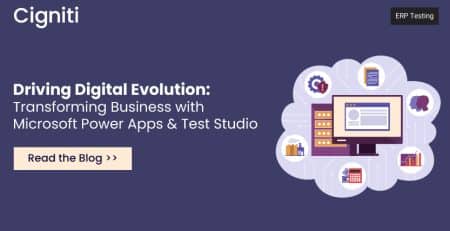5 Testing Tips for CXOs to Ensure Successful ERP Implementation
|
Listen on the go!
|
Enterprise Resource Planning (ERP) systems have become the backbone of modern businesses, streamlining processes and enhancing efficiency. However, an ERP system’s successful implementation and operation require meticulous testing to ensure it aligns seamlessly with your business needs. This comprehensive guide will explore what ERP is, the types of ERP testing, and its benefits that ensure your ERP system functions flawlessly.
What is ERP?
At its core, ERP is a business process management software that allows an organization to use a system of integrated applications to manage and automate many back-office functions related to technology, services, and human resources. It facilitates the flow of information between all business functions and ensures data consistency and accuracy.
What are the Different Types of ERP Testing?
Effective ERP testing is essential for achieving a smooth and successful ERP implementation. Below are the key types of ERP testing that organizations should consider:
1. User Acceptance Testing (UAT)
User Acceptance Testing is the final stage of ERP testing and is conducted by end-users to ensure the system meets their needs and works as expected. It involves executing real-world scenarios to validate whether the ERP system aligns with business processes and objectives. UAT helps identify and address usability, functionality, and data integrity issues. Successful UAT is a significant milestone that indicates the readiness of the ERP system for production use.
Benefits of UAT:
- Alignment with user needs: UAT ensures that the ERP system aligns with the specific needs and expectations of end-users.
- Functional validation: It verifies that the system functions as intended, addressing usability, functionality, and data integrity.
- User training: UAT provides an opportunity to train end-users in a real-world environment, improving their readiness for system adoption.
2. System Integration Testing (SIT)
System Integration Testing focuses on verifying the seamless interaction between various components of the ERP system. It involves testing how different modules, applications, and third-party integrations work together. The goal is to identify and rectify integration issues, data inconsistencies, or communication errors. SIT ensures that data flows accurately between different parts of the ERP system.
Benefits of SIT:
- Integration validation: SIT verifies that different ERP modules and integrations work seamlessly, preventing data inconsistencies.
- Workflow testing: It validates end-to-end business processes, ensuring smooth data flow and accurate results.
- Early issue identification: SIT identifies integration issues before they impact production, reducing the risk of operational disruptions.
3. Performance and Load Testing
Performance and Load Testing are critical to ensuring the ERP system can handle the expected workload without degradation. It involves simulating various user scenarios, such as peak loads and concurrent users, to assess the system’s response time, scalability, and resource utilization. Identifying and addressing performance bottlenecks is essential to prevent system slowdowns and downtime during peak usage.
Benefits of Performance and Load Testing:
- Scalability assessment: It assesses the system’s ability to handle increased workloads, supporting business growth.
- Response time optimization: Performance testing identifies bottlenecks and slowdowns, allowing for optimization.
- Reliability assurance: Ensures the ERP system remains responsive and reliable even during peak usage.
4. Data Integration Testing
In today’s data-driven business landscape, organizations rely heavily on central systems like ERP (Enterprise Resource Planning), CRM (Customer Relationship Management), financial systems, and HR systems to manage critical operations. These systems continuously exchange data feeds, often in XML or flat file formats, with various stakeholders, including customers, vendors, and other internal systems. These data interfaces are pervasive across industries, from finance and pharmaceuticals to retail and utilities, and are instrumental in ensuring the smooth flow of crucial information.
However, as systems grow more complex and data volumes expand, identifying and rectifying data defects before they impact target systems becomes increasingly daunting. This challenge stems from several key factors, such as business constraints, technology hurdles, resource limitations, etc.
Benefits of Data Integration Testing:
- Enhanced Data Accuracy and Consistency: Integrating internal and external data feeds allows for real-time or near-real-time data synchronization. This means that data is consistently updated across various systems and departments. When data is accurate and consistent, it reduces the likelihood of errors, discrepancies, and data conflicts.
- Improved Operational Efficiency: Integrating data feeds streamlines processes and reduces manual data entry and data manipulation efforts. This improves operational efficiency as employees spend less time on data-related tasks and can focus on higher-value activities.
- Data-Driven Insights and Decision-Making: Integrating internal and external data feeds provides a holistic view of business data. This comprehensive data pool enables organizations to perform advanced analytics, generate insights, and make data-driven decisions. By combining internal data with external data sources, such as market trends, customer behavior, or industry benchmarks, organizations can gain a competitive edge and adapt more effectively to changing market conditions.
5. Security and Penetration Testing
Security is paramount for ERP systems, which often handle sensitive business data. Security and Penetration Testing help identify vulnerabilities and weaknesses in the ERP system’s security infrastructure. It involves simulating cyberattacks and assessing the system’s ability to withstand security threats. Addressing security issues early in testing is crucial to safeguarding an organization’s ERP system and protecting sensitive information.
Benefits of Security and Penetration Testing:
- Vulnerability identification: It identifies potential security vulnerabilities and weaknesses in the ERP system.
- Risk mitigation: Security testing helps mitigate the risk of data breaches and unauthorized access.
- Compliance assurance: Ensures the ERP system complies with industry-specific security standards and regulations.
Optimizing ERP for Improved Business Efficiency
Enterprise resource planning is a business process that manages core functions and integrates information across an organization. Successful ERP implementation and operation depend on meticulous testing across various dimensions, including User Acceptance Testing, System Integration Testing, Performance and Load Testing, Automated Testing, and Security and Penetration Testing. Each testing phase uniquely ensures that the ERP system functions seamlessly, aligns with business goals, and remains secure.
By prioritizing ERP testing and addressing any issues discovered during the testing process, organizations can optimize the performance and reliability of their ERP systems, leading to improved efficiency and a competitive edge in today’s dynamic business landscape.
Need help? Read more about Cigniti’s ERP Testing Services and QuerySurge ERP Testing Solutions to learn how we can speed up your ERP and ERP testing efforts.





Leave a Reply